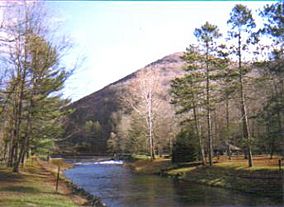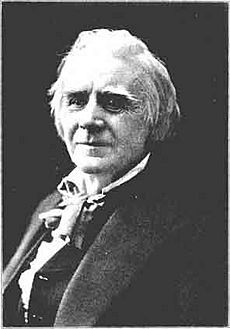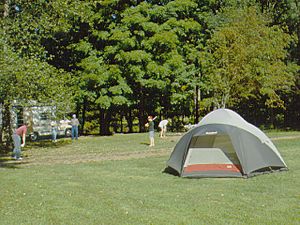Ole Bull State Park facts for kids
Quick facts for kids Ole Bull State Park |
|
|---|---|
|
IUCN Category III (Natural Monument)
|
|

Kettle Creek flowing through Ole Bull State Park
|
|
| Location | Stewardson, Potter, Pennsylvania, United States |
| Area | 132 acres (53 ha) |
| Elevation | 1,417 ft (432 m) |
| Established | 1925 |
| Named for | Ole Borneman Bull |
| Governing body | Pennsylvania Department of Conservation and Natural Resources |
| Website | Ole Bull State Park |
Ole Bull State Park is a 132-acre Pennsylvania state park. It is located in Stewardson Township, Potter County, Pennsylvania. The park sits along Pennsylvania Route 144. It is about 26 miles north of Renovo and 18 miles south of Galeton.
Ole Bull State Park is in the Kettle Creek Valley. It is surrounded by Susquehannock State Forest. The forests around the park are called the Black Forest. This name comes from how thick the trees used to be.
Contents
History
Ole Bull's Dream: New Norway
Ole Bull State Park is named after Ole Borneman Bull. He was a very famous Norwegian violin player. Ole Bull visited the United States many times. He had a great idea to start a new home for people from Norway.
In 1852, he bought 120,000 acres of land in Pennsylvania. He paid $10,000 for it. He called his new settlement New Norway. He started four small towns there. These were New Bergen, Oleona, New Norway, and Valhalla. They were all in the Kettle Creek area. Ole Bull even started building a "castle" called Nordjenskald.
But the dream did not last long. The castle and towns were left empty in less than a year. The Norwegian settlers were farmers. They found it very hard to clear the land of so many trees. This was a new challenge for them. A Norwegian folk song from 1853, called Oleanna, made fun of these struggles.
Even though the settlement failed, Ole Bull was not forgotten. The people of Norway paid for a statue to honor him. This statue was placed in the park in 2002. This was 150 years after New Norway was founded.
The Lumber Era
The Kettle Creek area was once full of trees. In the 1880s and 1890s, many companies came to cut down these trees. This was a huge logging operation. They cut down tall white pine and hemlock trees.
Two railroad lines were built along Kettle Creek. These trains carried the cut timber to sawmills. The sawmills were in the Cross Fork area. Soon, almost all the old, big trees were gone. The land was no longer useful for logging.
The Commonwealth of Pennsylvania bought much of this land. Ole Bull State Park was then opened in 1925.
Building the Park: Civilian Conservation Corps
Many buildings and areas in Ole Bull State Park were built during the Great Depression. This was a time when many people did not have jobs. The Civilian Conservation Corps (CCC) helped. This program was started by President Franklin D. Roosevelt.
The CCC gave jobs to many people who were out of work. They built many things in parks across Pennsylvania. At Ole Bull State Park, they built outhouses, pavilions, and camping areas. The CCC also built the first dam in the swimming area. Their work helped create the park we see today.
Recreation
Hunting and Fishing Fun
You can go hunting on 25 acres of Ole Bull State Park. Hunters must follow the rules of the Pennsylvania State Game Commission. You might see ruffed grouse, squirrels, turkeys, white-tailed deer, and black bears. There are also many more acres for hunting in the nearby Susquehannock State Forest.
The water in Kettle Creek and Ole Bull Run is very clean. You can fish for brook, rainbow, and brown trout. There is a special fishing spot for children and people with disabilities. It is near the dam on Kettle Creek. Please do not fish near the dam wires or in the swimming area.
Swimming and Camping Adventures
You can go swimming at the 150-foot sandy beach on Kettle Creek. The beach is open from May to mid-September. There are no lifeguards, so you swim at your own risk. Pets are not allowed on the beach.
Camping is allowed all year at Ole Bull State Park. There are two camping areas along Kettle Creek. Some spots are sunny, and some are shady. One area has 24 electric hookups, and the other has 21. All campsites have a flat gravel spot for your camper. They also have a fire ring and a picnic table. The park has modern restrooms, water, and a place to empty waste from campers.
Picnics and Exploring Trails
The picnic area is across Kettle Creek from the swimming area. It has four pavilions, many picnic tables, and a playground. There are also fireplaces, a restroom, and water. The Stone Pavilion has electricity. You need to reserve this pavilion to use the electricity.
Ole Bull State Park is a starting point for the 85-mile Susquehannock Trail System. The park also has 2 miles of its own trails. The Daugherty Loop Trail uses old logging roads and a railroad path. It goes through the Black Forest. The Beaver Dam Nature Trail follows Kettle Creek for about 0.75 miles. The Ole Bull Trail leads to the remains of Ole Bull's "castle," Nordjenskald. From here, you get a great view of the park.
In winter, you can go cross-country skiing, snowshoeing, and snowmobiling on the trails.
Nearby state parks
These state parks are within 30 miles of Ole Bull State Park:
- Bucktail State Park Natural Area (Cameron and Clinton Counties)
- Cherry Springs State Park (Potter County)
- Colton Point State Park (Tioga County)
- Denton Hill State Park (Potter County)
- Hyner Run State Park (Clinton County)
- Hyner View State Park (Clinton County)
- Kettle Creek State Park (Clinton County)
- Little Pine State Park (Lycoming County)
- Leonard Harrison State Park (Tioga County)
- Lyman Run State Park (Potter County)
- Patterson State Park (Potter County)
- Prouty Place State Park (Potter County)
- Sinnemahoning State Park (Potter and Cameron Counties)
- Sizerville State Park (Cameron and Potter Counties)
- Upper Pine Bottom State Park (Lycoming County)
Images for kids





